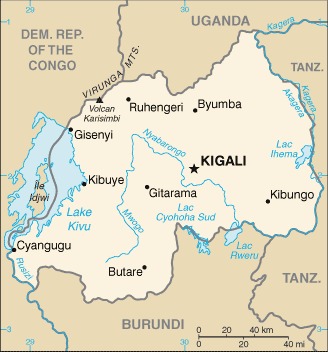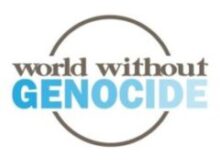Rwandan Genocide

Rwanda The World Factbook 2021. Washington, DC: Central Intelligence Agency, 2021. https://www.cia.gov/the-world-factbook/
What
The “Rwandan Genocide” refers to the 1994 mass slaughter in Rwanda of the ethnic Tutsi and politically moderate Hutu peoples. The killings began in early April of 1994 and continued for approximately one hundred days until the “Hutu Power” movement’s defeat in mid-July. The genocide was carried out primarily by Hutu supremacist militia groups, co-perpetrated by the state government of Rwanda, the Rwandan Army, and Rwandan civilians in compliance with the “Hutu Power” movement. [1] By its conclusion, at least 500,000 ethnic Tutsis were murdered, along with thousands of Tutsi sympathizers, moderate Hutus, and other victims of atrocity. Some estimates claim anywhere between 800,000- 1,000,000 killed, with another 2 million refugees (mostly Hutus fearing the retribution of the newly-empowered Tutsi rebel government) packed in disease-ridden refugee camps of neighboring Burundi, Tanzania, Uganda, and former Zaire.[2]
Where
Rwanda is a very small country (about the size of Maryland), located near the center of Africa, a few degrees south of the Equator. [3] It is separated from the Democratic Republic of Congo (former Zaire) by Lake Kivu and the Ruzizi River valley to the west; it is bounded on the north by Uganda, to the east by Tanzania, and to the south by Burundi. The capital, Kigali, is located in the center of the country. As of 1994, the population of Rwanda was estimated at 7 million, with 85 percent of the population in the Hutu ethnic group, 14 percent Tutsi, and 1 percent Twa. [4] The Rwandan Genocide itself began with mass killings in Kigali, but over the course of its 100-day duration, killing spread to all corners of the country.
When
The Rwandan genocide took place over a time span of only 100 days, between April and July 1994.
Victims
Hutu nationalist group Parmehutu led a social revolution in 1959, which overthrew the Tutsi ruling class, resulting in the death of around 20,000 Tutsis and the exile of another 200,000 to neighboring countries. [5] Rwandan independence from Belgium would follow in 1961, marking the establishment of a Hutu-led Rwandan government. The Tutsis remaining in Rwanda, mostly due to intermarriage or other family ties, would be discriminated against as racially “lesser” citizens by the new Hutu government.[6] The RPF (Rwandan Patriotic Front) was formed in as a political group of Tutsi nationalist exiles who demanded the right to return to their homeland as citizens and an end to social discrimination against the Tutsi in Rwanda.[7] The RPF rebels invaded Rwanda from neighboring Uganda in October of 1990.[8] This act of Tutsi aggression, coupled with decades of discrimination and fear for a loss of power, paved the way to genocide. During the 1994 genocide, thousands of Tutsi were killed, along with moderate Hutus who sympathized with their Tutsi neighbors and resisted by defending, hiding, or providing aid to their Tutsi neighbors.[9]
Perpetrators
Most of the killing was carried out by two Hutu radical militant groups: the Interahamwe and the Impuzamugambi. Armed, backed, and led by the government of Rwanda (MRND), the Interahamwe are remembered today as the driving force of the genocide, comprised mostly of young Hutu men, influenced by the “Hutu Power” ideology.[10] Springing from a separate political entity, the CDR, the Impuzamugambi was made up of members of the CDR’s youth wing. These forces were fewer in number than those of the Interahamwe.[11] The “more-extreme” anti-Tutsi agenda of the CDR reflected on the Impuzamugambi; their killings were often regarded as less organized, and more vicious. The genocide was obviously supported by the Hutu-led government (MRND) and members of the Rwandan army: they armed and directed militias, dispatched killing orders, and even participated in the rounding up of victims themselves. The most unsettling co-perpetrators of the genocide, however, were those Rwandan civilians who collaborated with and supported the genocide. Many Tutsis and moderate Hutus were handed over and/or killed by their own neighbors, also bent on anti-Tutsi sentiment.[12]
How
Unlike other genocides of the 20th century, the Rwandan genocide unfolded before the eyes of the national media. Journalists, radio broadcasters, and TV news reporters covered the events live from Rwanda, until the violence escalated to fanatical levels and all foreigners were encouraged to evacuate. [13]In short, the world knew of the genocide from its first day up until its conclusion. Mark Doyle, a reporter for the BBC in Kigali, tried to explain the situation to the world in late April 1994 as follows,
“…you have to understand that there are two wars going on here. There’s a shooting war and a genocide war. The two are connected, but also distinct. In the shooting war, there are two conventional armies at each other, and in the genocide war, one of those armies, the government side with help from civilians, is involved in mass killings.”[14]
UNAMIR, the UN peacekeeping force in Rwanda, was present on the ground throughout the course of the genocide. With disregard to the violence portrayed in the national media, France, Belgium, and the United States declined to send additional support, despite UNAMIR’s specific warnings to the UN Security Council in early 1994, describing the Hutu militia’s plan for extermination.[15] The Security Council denied UNAMIR’s request to intervene, and in early April, the Belgian contingency of UNAMIR’s force were pulled out, due to the murder of ten Belgian soldiers. Almost overnight, 4500 UNAMIR peacekeepers on the ground were reduced to a mere 260. Not until mid-May (approx. 500,000 Rwandans had already been killed) did the UN recognize that “acts of genocide may have been committed,” at which point the UN pledged to send in 5,500 troops and 50 armored personal carriers. This force, however, was further delayed due to continuing arguments between the UN and the U.S. army over the cost of the Armored Personnel Carriers. The genocide would be ended by the RPF overthrow of the Hutu Regime in July; the UN intervention never occurred.[16] The state support for the genocide in Rwanda was no doubt one of its primary engines. The Hutu-led government provided arms, planning, and leadership for the militias. It also funded the RTLM “Hutu Power” radio broadcast, the primary source of “brainwashing” for the Rwandan civilians who also took part in the genocide. [17]
Response
Immediately following the RPF takeover in July of 1994, around 2 million Hutus (perpetrators, bystanders, and resistors to the genocide) fled into the neighboring countries to avoid potential Tutsi retribution. Thousands died of epidemics, which spread like wildfire through to overcrowded refugee camps. [18] The refugee presence in Zaire, among other factors, led to the first Congo War in 1996 and the formation of the Democratic Republic of Congo. [19] Due to worsening conditions in the DRC and Tanzania, more than a million Rwandan refugees would return home by 1997. [20] Back in Rwanda, the fully regenerated “UNAMIR 2” assumed control until March 8th, 1996.[21] They faced the enormous task of cleaning up a war-torn country side and dealing with the bodies of more than 1 million victims of genocide and war. The “machete” would become a symbol, synonymous to the Rwandan genocide for its widespread use by untrained civilians, to hack their neighbors to death. With the return of the refugees, the long-awaited genocide trials could proceed. The International Criminal Tribunal for Rwanda, located in Arusha, Tanzania, began proceedings in 1996. [22] As of October 2019, the Tribunal has indicted 93 individuals and concluded the proceedings of 80 of those individuals, 62 of which have been convicted guilty of war crimes, acts of genocide, rape, and the creation of “hate media.” The Tribunal closed at the end of 2015. [23]
Future
Looking forward, Rwanda is actively continuing to pursue justice for the genocide by requesting extradition treaties with other governments to arrest and try the remaining genocide perpetrators who have been indicted. The RPF have continued their rule since 1994 and have actively worked to squash any political opposition that have risen over the years. This has led to political repression and severe intimidation, thereby limiting freedom of expression and journalist’s reporting on the ill-treatment, torture, and illegal detention of many citizens. [24]
Updated January 2021.
References
[1] “Leave None to Tell the Story: Genocide in Rwanda – The Genocide,” Human Rights Watch, https://www.hrw.org/reports/1999/rwanda/Geno1-3-02.htm (18 August 2018).
[2] E.g. Romeo Dallaire, Shake Hands with the Devil: The Failure of Humanity in Rwanda (London: Random House, 2004); “Rwanda: How the genocide happened,” BBC, https://www.bbc.co.uk/news/world-africa-13431486 (18 August 2018); Philip Gourevitch, We Wish to Inform You that Tomorrow We Will Be Killed with Our Families: Stories from Rwanda (New York: Picador, 1998); “Outreach Programme on the Rwanda Genocide and the United Nations – Rwanda: A Brief History of the country”, United Nations, http://www.un.org/en/preventgenocide/rwanda/education/rwandagenocide.shtml ( 18 August 2018).
[3] “Rwanda,” US Department of State, https://2009-2017.state.gov/outofdate/bgn/rwanda/57531.htm (18 August 2018).
[4] “Rwanda: Background,” United States Holocaust Memorial Museum, https://www.ushmm.org/confront-genocide/cases/rwanda/rwanda-background (18 August 2018).
[5] “Rwanda: How the genocide happened,” BBC, https://www.bbc.co.uk/news/world-africa-13431486 (18 August 2018); “Rwandan History: Pre-Genocide,” SURF, https://survivors-fund.org.uk/learn/rwandan-history/pre-genocide/ (18 August 2018).
[6] “Leave None to Tell the Story: Genocide in Rwanda – History,” Human Rights Watch,
https://www.hrw.org/reports/1999/rwanda/Geno1-3-09.htm#P233_103259, (18 August 2018).
[7] “Leave None to Tell the Story: Genocide in Rwanda – The Rwandan Patriotic Front,” Human Rights Watch,
https://www.hrw.org/reports/1999/rwanda/Geno15-8-03.htm, (23 August 2018).
[8] Scott Straus, The Order of Genocide: Race, Power, and War in Rwanda (New York: Cornell University Press, 2006).
[9] “Leave None to Tell the Story: Genocide in Rwanda – History,” Human Rights Watch,
https://www.hrw.org/reports/1999/rwanda/Geno1-3-09.htm#P233_103259, (18 August 2018); Philip Gourevitch, We Wish to Inform You that Tomorrow We Will Be Killed with Our Families: Stories from Rwanda (New York: Picador, 1998).
[10] E.g. “Leave None to Tell the Story: Genocide in Rwanda – The Genocide,” Human Rights Watch, https://www.hrw.org/reports/1999/rwanda/Geno1-3-02.htm (18 August 2018); Philip Gourevitch, We Wish to Inform You that Tomorrow We Will Be Killed with Our Families: Stories from Rwanda (New York: Picador, 1998).
[11] “Leave None to Tell the Story: Genocide in Rwanda – Organization,” Human Rights Watch, https://www.hrw.org/reports/1999/rwanda/Geno4-7-03.htm (18 August 2018);
[12] “Leave None to Tell the Story: Genocide in Rwanda – Organization,” Human Rights Watch, https://www.hrw.org/reports/1999/rwanda/Geno4-7-03.htm (18 August 2018);
[13] “Ghosts of Rwanda,” Frontline (2004).
[14] “Ghosts of Rwanda,” Frontline (2004).
[15] “Leave None to Tell the Story: Genocide in Rwanda – Ignoring Genocide,” Human Rights Watch,
https://www.hrw.org/reports/1999/rwanda/Geno15-8-01.htm (18 August 2018); Philip Gourevitch, We Wish to Inform You that Tomorrow We Will Be Killed with Our Families: Stories from Rwanda (New York: Picador, 1998).
[16] E.g. “Leave None to Tell the Story: Genocide in Rwanda – Ignoring Genocide,” Human Rights Watch,
https://www.hrw.org/reports/1999/rwanda/Geno15-8-01.htm (18 August 2018);
[17] E.g. Thompson, Allan, editor, The Media and the Rwanda Genocide (London: Pluto Press, 2007).
[18] E.g. Mark Cutts, “Chapter 10: The Rwandan genocide and its aftermath” in The State of the World’s Refugees 2000: Fifty Years of Humanitarian Action by United Nations High Commissioner for Refugees (Geneva: UNHCR, 2000), http://www.unhcr.org/en-my/3ebf9bb60.pdf (19 August 2018); “The Refugee Crisis,” Rwandan Stories, http://www.rwandanstories.org/genocide/refugee_crisis.html (19 August 2018)
[19] “Rwanda: Aftermath,” United States Holocaust Memorial Museum, https://www.ushmm.org/confront-genocide/cases/rwanda/rwanda-aftermath (19 August 2018).
[20] “U.S. Committee for Refugees World Refugee Survey 1997 – Rwanda,” United States Committee for Refugees and Immigrants, http://www.refworld.org/docid/3ae6a8b90.html (23 August 2018).
[21] “UNAMIR”, United Nations, https://peacekeeping.un.org/mission/past/unamirS.htm (23 August 2018).
[22] “The ICTR in Brief”, United Nations International Residual Mechanism for Criminal Tribunals http://unictr.irmct.org/en/tribunal (23 August 2018).
[23] https://unictr.irmct.org/en/cases/key-figures-cases
[24] https://www.hrw.org/world-report/2020/country-chapters/rwanda




